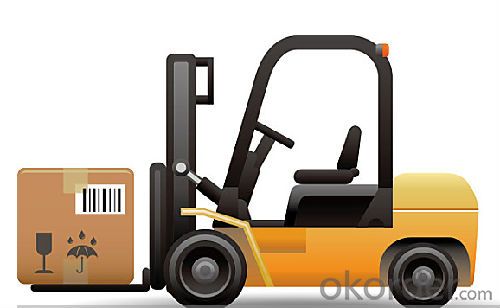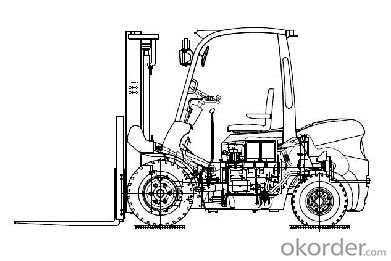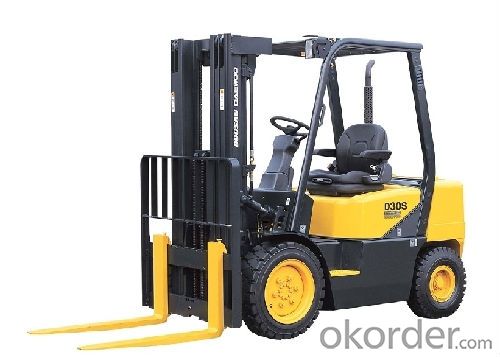Loading Port:Shanghai
Payment Terms:TT or LC
Min Order Qty:1 unit
Supply Capability:1 unit/month
Description of forklift:
A forklift truck (also called a lift truck, a fork truck, or a forklift) is a powered industrial truck used to lift and move materials short distances. The forklift was developed in the early 20th century by various companies including the transmission manufacturing company Clark and the hoist company Yale & Towne Manufacturing. Following World War II the use and development of the forklift truck has greatly expanded worldwide. Forklifts have become an indispensable piece of equipment in manufacturing and warehousing operations. In 2013 alone the top 20 manufacturers worldwide posted sales of $30.4 billion with 944,405 machines sold.;and the U.S. forklift market was nearly $33 billion.
Forklift cab with control layout.
Forklifts are rated for loads at a specified maximum weight and a specified forward center of gravity. This information is located on a nameplate provided by the manufacturer, and loads must not exceed these specifications. In many jurisdictions it is illegal to remove or tamper with the nameplate without the permission of the forklift manufacturer.
An important aspect of forklift operation is that most have rear-wheel steering. While this increases maneuverability in tight cornering situations, it differs from a driver’s traditional experience with other wheeled vehicles. While steering, as there is no caster action, it is unnecessary to apply steering force to maintain a constant rate of turn.
Another critical characteristic of the forklift is its instability. The forklift and load must be considered a unit with a continually varying center of gravity with every movement of the load. A forklift must never negotiate a turn at speed with a raised load, where centrifugal and gravitational forces may combine to cause a disastrous tip-over accident. The forklift are designed with a load limit for the forks which is decreased with fork elevation and undercutting of the load (i.e., when a load does not butt against the fork "L"). A loading plate for loading reference is usually located on the forklift. A forklift should not be used as a personnel lift without the fitting of specific safety equipment, such as a "cherry picker" or "cage".
Technical data of forklift:
1KG=2.2LB 1INCH=25.4MM
Mast Table FE3R06-12AC | Capacity(lb)c=500mm | ||||||||
Designtion | Lift height | Free lift | Closed mast height h1 mm | Extended mast height h4 mm | Tilt forward/ | without sideshift single solid rubber | |||
FE3R06AC | FE3R08AC | FE3R10AC | FE3R12AC | ||||||
Two-stage | 2500 | 0 | 1560 | 3430 | 3/5.3 | 600 | 800 | 1000 | 1200 |
3000 | 0 | 2005 | 3875 | 3/5.3 | 600 | 800 | 1000 | 1200 | |
3600 | 0 | 2305 | 4175 | 3/5.3 | 560 | 720 | 920 | 1050 | |
4000 | 0 | 2305 | 4375 | 3/5.3 | 480 | 650 | 800 | 950 | |
Two-stage full free | 2500 | 1450 | 1955 | 3835 | 3/5.3 | 600 | 800 | 1000 | 1200 |
3000 | 1500 | 2005 | 3875 | 3/5.3 | 600 | 800 | 1000 | 1200 | |
3600 | 1800 | 2305 | 4175 | 3/5.3 | 560 | 720 | 920 | 1050 | |
4000 | 2000 | 2505 | 4375 | 3/5.3 | 480 | 650 | 800 | 950 | |
Three-stage full free | 4000 | 1300 | 1780 | 4375 | 3/5.3 | 450 | 630 | 750 | 900 |
4200 | 1400 | 1880 | 5140 | 3/5.3 | 430 | 600 | 720 | 800 | |
4500 | 1500 | 2005 | 5340 | 3/5.3 | 380 | 500 | 580 | 700 | |
Identification | Manufacture(abbreviation) | Noblellift | ||||
Manufacturer’s type designation | FE3R06AC | FE3R08AC | FE3R10AC | FE3R12AC | ||
Drive:electric(battery or mains), | electric | |||||
Type of operation: hand, pedestrian, standing,seated,order-picker | seated | |||||
Load Capacity /rated load | kg | 600 | 800 | 1000 | 1200 | |
Load center distance | mm | 500 | ||||
Load distance, centre of drive axle to fork | mm | 250 | 260 | |||
Wheelbase | mm | 812/897 | 952/1037 | |||
Weights | Service Weight incl.battery(see line 6.5) | kg | 1740 | 1850 | 2050 | 2200 |
Axle loading, laden front/rear | kg | 1960/380 | 2235/415 | 2530/520 | 2720/580 | |
Axle loading, unladen front/rear | kg | 760/980 | 800/1050 | 860/1090 | 910/1290 | |
Wheels, | Tyres:solid rubber, superelastic,pneumatic,polyurethane | Solid rubber/polyurethane | ||||
Tyres size, front | 13×4 1/2×8 | |||||
Tyres size, rear | Ф254×82 | Ф310×125 | ||||
Wheels, number front/rear(x=driven wheels) | 2/1× | |||||
Track width,front | mm | 731 | ||||
Track width,rear | mm | 0 | ||||
Basic Dimensions | Mast/fork carriage tilt forward/backward | α/β | 3°/5.3° | |||
Lowered mast height | mm | 2000 | ||||
Free lift | mm | 0 | ||||
Lift height | mm | 3000 | ||||
Extended mast height | mm | 3875 | ||||
Overhead load guard height | mm | 2000 | 2090 | |||
Seat height/standing height | mm | 945 | 1030 | |||
Coupling height | mm | 760 | 860 | |||
Overall length | mm | 2290 | 2410 | |||
Length to face of forks | mm | 1290 | 1460 | |||
Overall width | mm | 845 | 850 | |||
Fork dimensions | mm | 30×100×1000 | 35×100×1150 | |||
Fork carriage width | mm | 845 | 850 | |||
Ground clearance,laden, under mast | mm | 70 | ||||
Ground clearance, center of wheelbase | mm | 65 | ||||
Aisle width for pallets 1000x1200 crossways | mm | 2775 | 2945 | |||
Aisle width for pallets 800x1200 lengthways | mm | 1890 | 1890 | |||
Turning radius | mm | 1040 | 1210 | |||
Performance Data | Travel Speed, laden/unladen | 8/9 | 8/9 | 7.5/9 | 7.0/9 | |
Lift speed, laden/unladen | m/s | 0.13/0.28 | 0.12/0.28 | 0.16/0.22 | 0.15/0.22 | |
Falling speed,laden/unladen | m/s | 0.22/0.22 | 0.23/0.22 | 0.16/0.20 | 0.17/0.20 | |
Drawbar pull laden/unladen | N | 1500/1700 | 1800/2300 | |||
Max puller,laden/unladen | N | 3320/3530 | 3420/3640 | |||
Gradient performance,laden/unladen | % | 8/12 | 8/12 | 10/15 | 10/15 | |
Service brake | hydr.+electric | |||||
E-Motor | Drive motor rating s2 60min | kw | 2.5 | 3 | ||
Lift motor rating at s3 15% | kw | 3 | ||||
Battery standard | DIN | |||||
Battery voltage, norminal capacity K5 | V/A | 24/360 | 24/460 | 24/540 | 24/600 | |
Battery weight | kg | 340 | 450 | 500 | 560 | |
Battery dimensions l/w/h | mm | 803/263/734 | 803/263/734 | 808/380/720 | 808/380/720 | |
Other Details | Type of drive control | Impulse AC | ||||
Operating pressure for attachments | MPa | 90 | 115 | 135 | 135 | |
Operating pressure for attachments | bar | 30 | ||||
Sound level at driver’s ear according to EN12053 | dB(A) | |||||
Images of forklift:



FAQ of forklift:
Q: What’s the function of forklift?
A: A forklift truck (also called a lift truck, a fork truck, or a forklift) is a powered industrial truck used to lift and move materials short distances. The forklift was developed in the early 20th century by various companies including the transmission manufacturing company Clark and the hoist company Yale & Towne Manufacturing. Following World War II the use and development of the forklift truck has greatly expanded worldwide. Forklifts have become an indispensable piece of equipment in manufacturing and warehousing operations.
Q: What’s the general operations of forklift:
A: Forklift cab with control layout.
Forklifts are rated for loads at a specified maximum weight and a specified forward center of gravity. This information is located on a nameplate provided by the manufacturer, and loads must not exceed these specifications. In many jurisdictions it is illegal to remove or tamper with the nameplate without the permission of the forklift manufacturer.
Q: What are the Forklift safety Standards?
A: 1, Forklift safety is subject to a variety of standards world wide. The most important standard is the ANSI B56—of which stewardship has now been passed from the American National Standards Institute (ANSI) to the Industrial Truck Standards Development Foundation after multi-year negotiations. ITSDF is a non-profit organization whose only purpose is the promulgation and modernization of the B56 standard.
2, Other forklift safety standards have been implemented in the United States by the Occupational Safety and Health Administration (OSHA) and in the United Kingdom by the Health and Safety Executive.
3, Driver safety: In many countries forklift truck operators must be trained and certified to operate forklift trucks. Certification may be required for each individual class of lift that an operator would use.